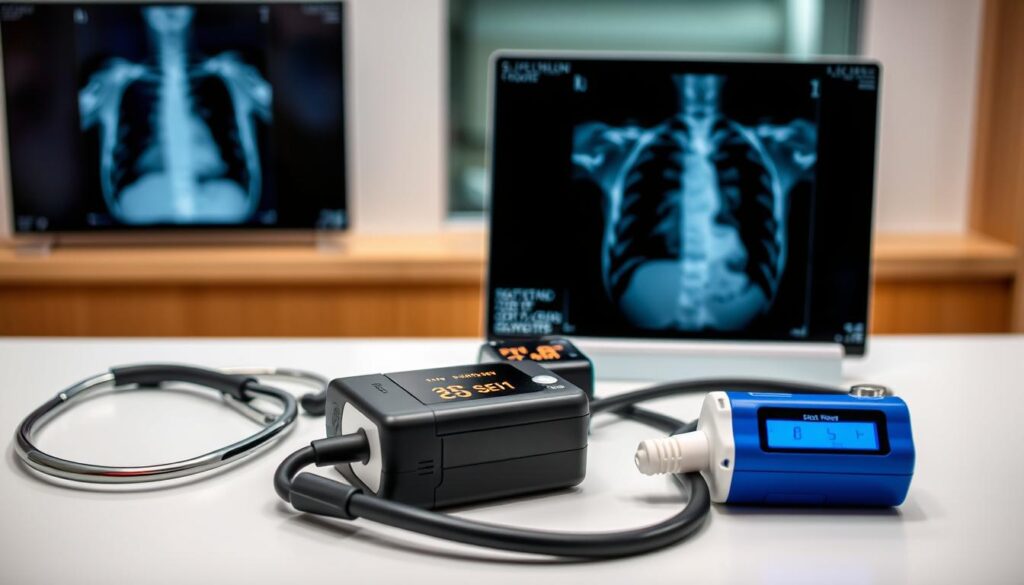Did you know that over 4 million people are hospitalized in the United States each year for respiratory illnesses? These can range from the common cold to serious lung diseases. They can greatly affect our health and well-being. In this article, we’ll explore the causes, symptoms, and how to manage respiratory illnesses. This will help you take charge of your respiratory health.
Key Takeaways
- Respiratory illnesses can range from mild to severe, affecting the lungs, airways, and overall respiratory system.
- Common causes of respiratory illnesses include viral and bacterial infections, allergies, environmental factors, and chronic conditions.
- Proper diagnosis and personalized treatment approaches, including medications and lifestyle changes, are crucial for managing respiratory illnesses effectively.
- Preventive measures, such as good hygiene practices and addressing risk factors, can help reduce the likelihood of developing respiratory illnesses.
- Respiratory health is especially important for children, and chronic conditions like asthma and COPD require specialized care and management.
What is a Respiratory Illness?
Respiratory illnesses affect the lungs and airways, making it hard to breathe. These lung diseases, breathing disorders, and pulmonary conditions can be mild or serious. They can come from infections, environmental factors, or health issues.
Types of Respiratory Illnesses
Here are some common respiratory illnesses:
- Asthma, a chronic condition that causes the airways to become inflamed and narrow
- Bronchitis, an inflammation of the bronchial tubes that can be acute or chronic
- Pneumonia, a lung infection that can be caused by bacteria, viruses, or fungi
- Chronic Obstructive Pulmonary Disease (COPD), a progressive lung disease that includes emphysema and chronic bronchitis
- Allergies, which can cause respiratory symptoms like sneezing, coughing, and wheezing
Common Symptoms
The symptoms of respiratory illnesses vary by condition. But common ones include:
- Coughing, which can be dry or productive
- Wheezing, a high-pitched whistling sound during breathing
- Shortness of breath or difficulty breathing
- Chest pain or discomfort
- Nasal congestion or runny nose
- Fatigue and weakness
These symptoms can vary in severity and last for different lengths of time. They can greatly affect a person’s life and health. Knowing about respiratory illnesses and their symptoms is key to getting the right medical care and managing them well.
Respiratory Illness Causes
Respiratory illnesses come from many sources. These include viruses, bacteria, pollution, allergies, and genetics. Knowing what causes these illnesses helps us prevent and manage them better.
Viral and bacterial infections are big culprits. Viruses like the flu and COVID-19 can make it hard to breathe. Bacterial infections, like pneumonia, also cause breathing problems.
Environmental factors like air pollution and cigarette smoke can also cause respiratory issues. These pollutants can irritate the lungs and airways. This can make breathing harder, especially for people with asthma or COPD.
Allergies are another big factor. People with allergies to pollen or dust mites may get symptoms like a runny nose and coughing. These symptoms happen when they’re exposed to what they’re allergic to.
Genetics can also play a role. Some lung diseases, like cystic fibrosis, are inherited. These conditions can affect how well the lungs work.
| Cause | Examples |
|---|---|
| Viral and Bacterial Infections | Influenza, COVID-19, Pneumonia |
| Environmental Factors | Air Pollution, Cigarette Smoke, Toxic Chemicals |
| Allergies | Pollen, Dust Mites, Mold |
| Genetic Factors | Cystic Fibrosis, Alpha-1 Antitrypsin Deficiency |
Understanding the causes of respiratory illnesses helps us take steps to prevent and manage them. This can lead to better lung health and overall well-being.
Risk Factors for Respiratory Illnesses
Respiratory illnesses can affect anyone. But some factors make you more likely to get sick. Knowing these risks helps keep your lungs healthy and prevents lung diseases and breathing problems.
Age and Immunity
As we get older, our immune systems get weaker. This makes older adults and young children more likely to get sick. Their bodies have a hard time fighting off infections that can harm the lungs.
Weak immunity can come from health issues, medicines, or just getting older. It’s a natural part of aging.
Environmental Factors
Where we live and work can affect our lungs. Air pollution, secondhand smoke, and certain jobs can harm our lungs. People in polluted areas or jobs with dust are at higher risk for lung diseases.
| Risk Factor | Impact on Respiratory Health |
|---|---|
| Age | Weakened immune system, increased susceptibility to infections |
| Air Pollution | Irritation and inflammation of the lungs, increased risk of lung diseases |
| Secondhand Smoke | Exposure to harmful chemicals, increased risk of respiratory illnesses |
| Occupational Hazards | Exposure to airborne particles, chemicals, or other irritants, increased risk of breathing disorders |
Knowing the risks for respiratory illnesses helps us protect our lungs. We can prevent many lung problems by taking care of ourselves.
Diagnosing Respiratory Illnesses
It’s very important to correctly diagnose respiratory illnesses. This helps doctors give the right treatment and care. They use many tools and methods to find out what’s wrong and how to fix it.
First, doctors do a thorough check-up. They look at the patient’s symptoms, past health, and examine the lungs. They might listen to the lungs, check for swelling, and look at the nose and throat.
Imaging tests like X-rays, CT scans, and MRI are also used. These tools show what’s happening inside the lungs and other parts of the respiratory system. They help find problems and help doctors figure out what’s wrong.
Lung function tests are key for checking how well the lungs work. These tests measure how much air a person can breathe in and out. They also check how fast air moves in and out. The results help doctors understand the illness and how serious it is.
| Diagnostic Tool | Purpose |
|---|---|
| Physical Examination | Assess symptoms, medical history, and inspect the respiratory system |
| Imaging Tests | Detect abnormalities and provide insights into the state of the lungs and respiratory organs |
| Lung Function Tests | Measure the efficiency of the respiratory system and assist in diagnosing respiratory illnesses |
By using these tools together, doctors can accurately diagnose respiratory illnesses. Then, they can create a treatment plan that meets the patient’s specific needs.

Treatment Options for Respiratory Illnesses
Managing respiratory illnesses needs a full plan, including medicines and lifestyle changes. Medicines like bronchodilators and corticosteroids help ease symptoms and improve lung function. These are for people with lung diseases, breathing disorders, and other pulmonary conditions.
Medications
Bronchodilators relax and widen airways, making breathing easier. They help with wheezing, chest tightness, and shortness of breath. Corticosteroids reduce swelling and inflammation in the lungs. They are great for chronic respiratory illnesses.
Lifestyle Changes
Changing your lifestyle can also help treat respiratory illnesses. Quitting smoking, improving air quality, and exercising regularly are good for your lungs. These changes can help manage lung diseases, breathing disorders, and other pulmonary conditions.
| Medication | Purpose | Examples |
|---|---|---|
| Bronchodilators | Relax and widen the airways | Albuterol, Ipratropium |
| Corticosteroids | Reduce inflammation in the lungs | Fluticasone, Budesonide |
“Comprehensive treatment for respiratory illnesses often involves a combination of medications and lifestyle modifications, tailored to the individual’s needs and condition.”
Exploring treatment options for respiratory illnesses helps individuals work with their healthcare providers. Together, they can create a plan that addresses lung diseases, breathing disorders, and other pulmonary conditions.
Preventing Respiratory Illness
Keeping your respiratory system healthy is key, especially with the rise of lung diseases and breathing disorders. Luckily, there are many ways to prevent these illnesses and keep you well.
Hygiene Practices
Good hygiene is a basic step in avoiding respiratory illnesses. Wash your hands often with soap and water, or use hand sanitizer if you can’t. Always cover your mouth and nose when you cough or sneeze to stop germs from spreading.
Keeping your living space clean also helps your respiratory health. Clean and disinfect often-touched areas like doorknobs and countertops. This can help cut down on germ spread.
- Wash your hands frequently with soap and water or use an alcohol-based hand sanitizer
- Cover your mouth and nose when coughing or sneezing, using a tissue or the crook of your elbow
- Clean and disinfect high-touch surfaces regularly to reduce the spread of germs
By making these hygiene habits a part of your daily life, you can lower your risk of getting respiratory illnesses. This helps keep your respiratory system healthy.

| Hygiene Practice | Benefits |
|---|---|
| Handwashing | Removes germs and prevents the spread of respiratory illnesses |
| Covering coughs and sneezes | Stops the transmission of respiratory droplets that can carry viruses and bacteria |
| Cleaning and disinfecting surfaces | Eliminates respiratory pathogens from high-touch areas |
By making these simple hygiene practices a part of your daily routine, you can lower your risk of respiratory illnesses. This helps keep your respiratory system healthy.
Respiratory Illness in Children
Respiratory illnesses can deeply affect children’s health and growth. These issues, from common to complex, need special care.
Asthma is a big problem for kids. It makes breathing hard, causing wheezing, coughing, and shortness of breath. Catching it early and treating it well is key to managing it.
Bronchiolitis is another common illness in kids. It’s a viral infection that hits the small airways hard. Young ones often have trouble breathing and eating. Quick medical help is vital to avoid serious problems.
| Respiratory Illness | Common Symptoms | Key Considerations |
|---|---|---|
| Asthma | Wheezing, coughing, shortness of breath | Early diagnosis and management are crucial |
| Bronchiolitis | Severe coughing, rapid breathing, difficulty feeding | Primarily affects infants and young children |
It’s important to know what kids with respiratory illnesses need. Pediatric lung diseases might need special treatments and close watch. This ensures kids get the best care possible.
“Respiratory illnesses in children can have a significant impact on their growth, development, and overall well-being. Early intervention and specialized care are crucial for managing these conditions effectively.”
Chronic Respiratory Illnesses
Some respiratory conditions are short-term, but others last a long time. Asthma and chronic obstructive pulmonary disease (COPD) are two common chronic illnesses. They can really affect a person’s life and health.
Asthma
Asthma is a long-term lung disease that causes airway inflammation and narrowing. People with asthma often have wheezing, chest tightness, and trouble breathing. These symptoms can be triggered by things like allergens or exercise.
Managing asthma well is key. This includes using the right medicines and avoiding things that can trigger attacks. This helps keep asthma under control and prevents serious attacks.
Chronic Obstructive Pulmonary Disease (COPD)
COPD is a group of lung diseases that make breathing harder. It includes emphysema and chronic bronchitis. Smoking is the main cause, but pollution and genetics can also play a role.
Symptoms of COPD include a persistent cough, wheezing, and shortness of breath. These symptoms get worse over time. But, there are treatments like medicines and oxygen therapy that can help manage COPD.
Managing chronic respiratory illnesses like asthma and COPD needs a full plan. This includes educating patients, making sure they take their medicine, and promoting healthy living. By understanding these conditions and their treatments, people can take charge of their respiratory health and improve their life quality.
| Condition | Cause | Symptoms | Treatment |
|---|---|---|---|
| Asthma | Inflammation and narrowing of airways | Wheezing, chest tightness, shortness of breath, coughing | Inhaled medications, identifying triggers |
| COPD | Smoking, air pollution, occupational exposures | Persistent coughing, wheezing, shortness of breath | Medications, oxygen therapy, lifestyle modifications |
“Effective management of chronic respiratory illnesses requires a comprehensive approach that combines patient education, medication adherence, and the adoption of healthy lifestyle habits.”
Respiratory Illness and COVID-19
The COVID-19 pandemic has shown us how important respiratory health is. People with lung problems like asthma or COPD are more at risk. They face serious challenges from the coronavirus.
Having a respiratory illness can weaken the lungs. This makes it harder for the body to fight off viruses like COVID-19. The virus can lead to severe problems, such as pneumonia and ARDS. Those with lung diseases may get sicker, need to go to the hospital, and have worse outcomes.
It’s crucial for people with respiratory issues to protect themselves. Following safety tips like wearing masks and staying away from others can help. Also, watching for symptoms, following treatment plans, and talking to doctors are key steps.










